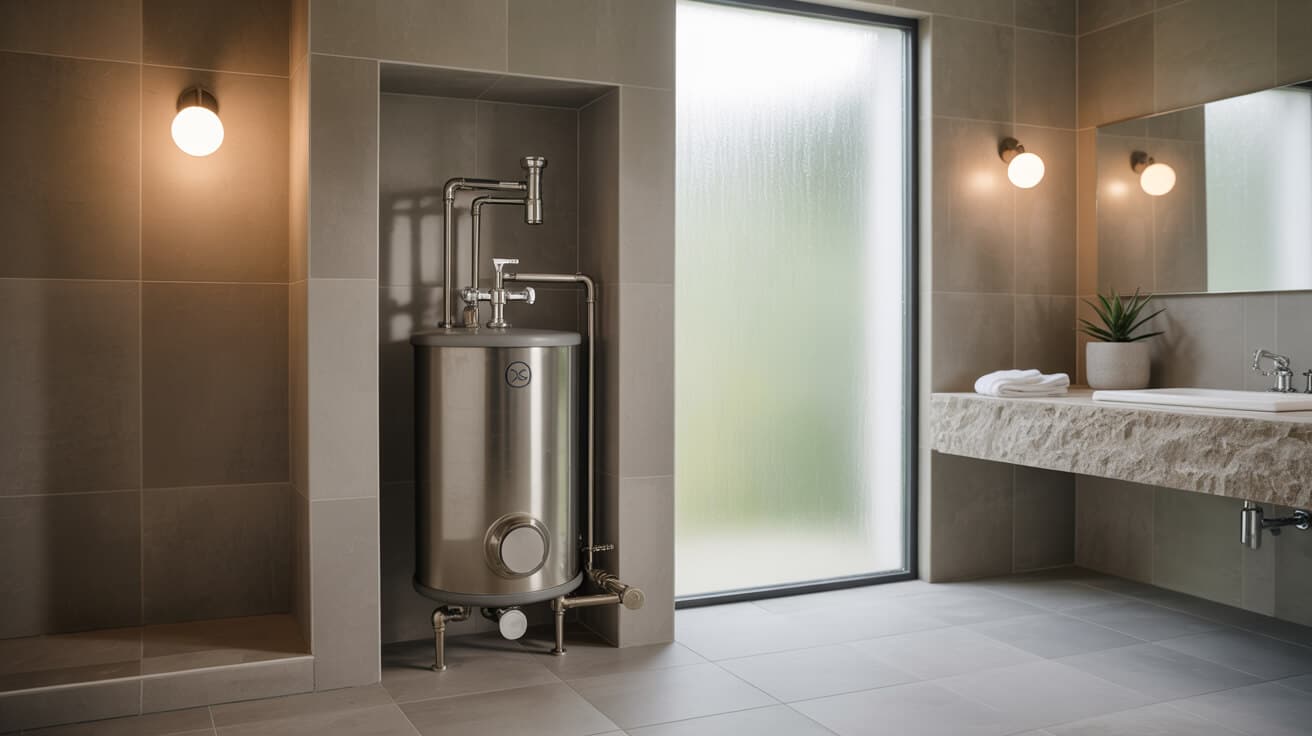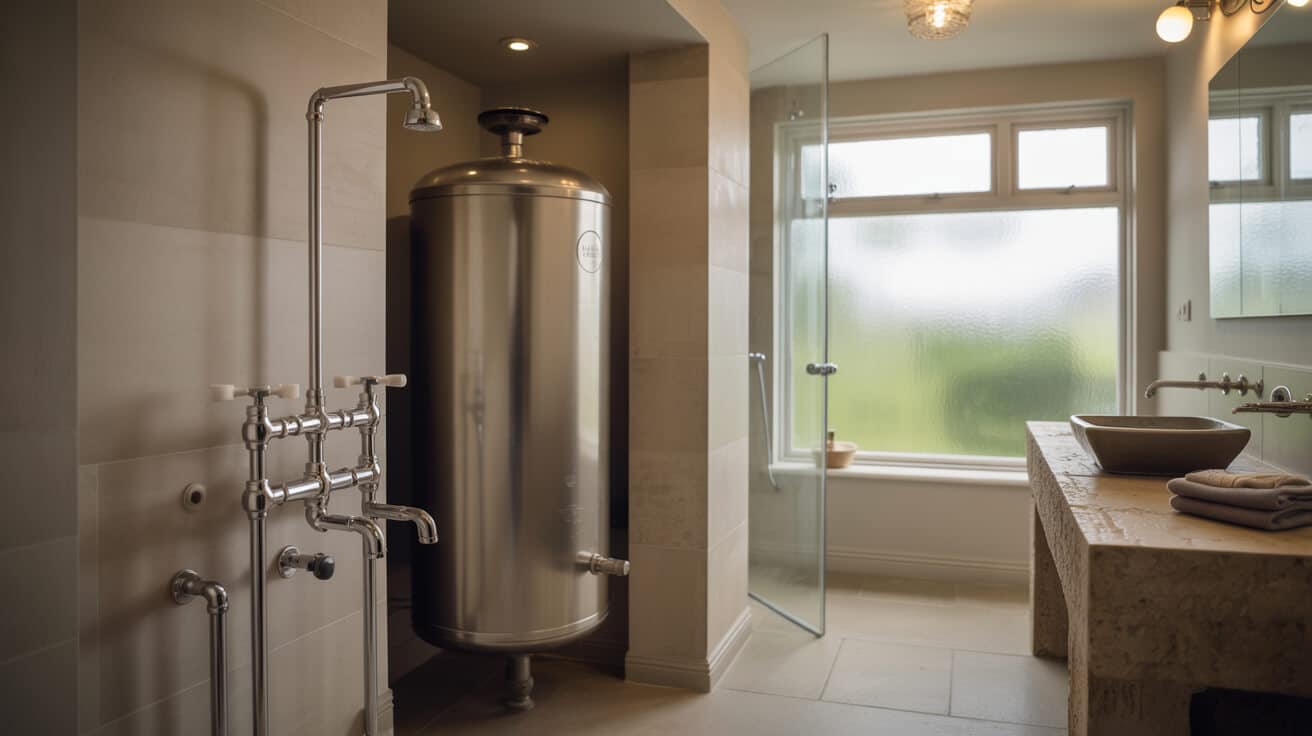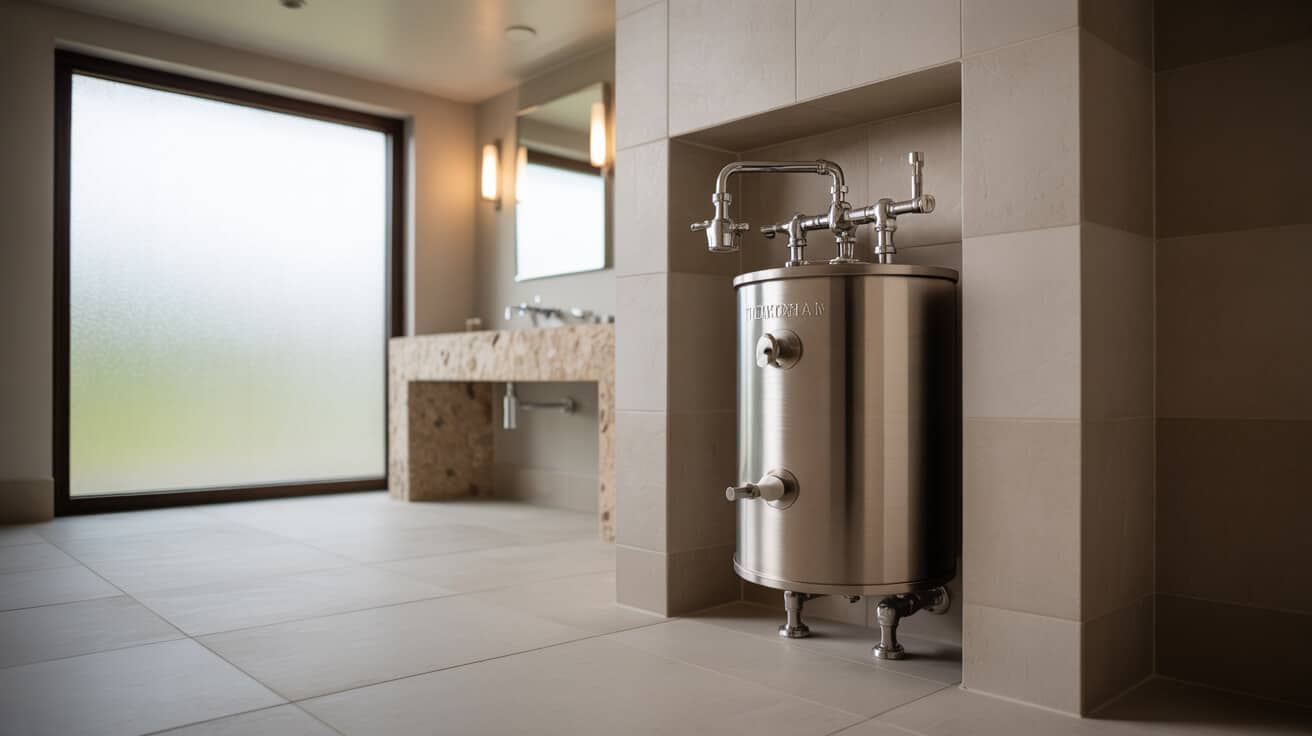A hot water cylinder is a closed vessel, typically constructed from copper or stainless steel, designed to store and deliver a continuous supply of heated water for domestic or commercial use. UK brands supporting this sector engineer a diverse range of products, balancing safety, insulation, rapid heat transfer, and rigorous compliance with British regulatory frameworks. Choices in system type, product capacity, and technical specifications directly affect comfort, operational efficiency, and legal compliance for your property, regardless of size or occupancy pattern.
Etymology or name origin
The epithet “cylinder” references the standardised barrel-like geometry employed in UK hot water storage, differentiated from tank constructs by both form and function. “Hot water cylinder” arose as a descriptor following the development of indirect heating (via internal coils), distinguishing these units from boilers or open-tank reservoirs. Regional plumbing dialects in the United Kingdom—such as the distinction between “cylinder” in England and “hot press” in Ireland—reflect both legacy and current usage. Sector abbreviations (UVC for “unvented cylinder,” for example) reflect the drive for technical precision in trade, installer, and manufacturer documentation.
Overview / context
Hot water cylinders provide an energy buffer between your property’s heating source and user demand, ensuring on-demand hot water at regulated pressures. These systems serve homeowner, landlord, facility manager, and developer needs across single dwellings, purpose-built flats, care homes, schools, and commercial properties. UK building regulation, fuel transition policy, and growing asset complexity have driven a proliferation of product designs, each tailored to distinct legacy, compliance, and sustainability objectives. Whether your organisation manages heritage tenements or modern builds, the cylinder brand you choose inevitably shapes your property’s operational resilience, tenant comfort, and regulatory standing.
History
Early developments
Early UK hot water vessels were simple copper barrels, fed by gravity from loft cisterns and heated through direct immersion or circulating fireside pipes. Pressurised, thermostatically-controlled units were rare, exposing users to the risks of scalding, bacterial growth, and waterhammer. The shift to more predictable hot water delivery paralleled developments in gas and electric energy supply, as well as cultural moves toward hygiene, routine bathing, and in-home comfort.
Industrial emergence
By the mid-20th century, manufacturers such as Heatrae Sadia, Gledhill, and Range began to dominate the landscape, capitalising on postwar skyscraper construction and mass social housing. Market competition and the growth of British Standards (BS 853 and BS 5449) fostered proprietary designs, sector-wide capacity norms, and standardised safety features. Gas and heating engineers gained prominence as regulatory authorities tied installation to legal compliance, requiring evidence of both manufacturer approval and sector training for complex pressurised systems.
Contemporary evolution
The launch and update of Building Regulations Part G, L, and P, as well as the mandatory implementation of WRAS (Water Regulations Advisory Scheme) and the G3 certificate for unvented hot water work, fundamentally shaped today’s cylinder brand matrix. Brands responded by diversifying into high-efficiency, composite-wrapped, and smart-control-ready lines, integrating solar and renewables compatibility, and expanding warranty periods to match shifting consumer expectations. Plumbers 4U and other installer networks now operate within a compliance-first market, with multi-brand sourcing and rapid deployment as critical assets for both residential and institutional buyers.

Concept / description
Functional principles
A hot water cylinder acts as a thermal store, holding water heated—directly or indirectly—for subsequent use. It balances peak demand with energy input cycles, stabilising water pressure and temperature to service taps, baths, and ancillary systems (such as closed-loop heating or underfloor circuits).
Key physical components
- Barrel or shell: Often stainless steel (duplex or 316L alloy for corrosion resistance) or copper.
- Primary coil: Transfers heat from a separate boiler, solar circuit, or heat pump.
- Expansion vessel: Compensates for thermal dilation in sealed (unvented) systems.
- Thermostats, immersion heaters, and temperature & pressure relief valves (TPRV): Ensure user safety, redundancy, and regulatory compliance.
- Integrated insulation: High-performance foam, 35–90 mm, reduces standing heat loss, conforming to SAP/ErP energy criteria.
Material distinctions
Copper is appreciated for bacteriostatic effects and reparability but is declining in high-pressure models and large-scale installations. Stainless steel, especially duplex grades, offers lightweight characteristics, improved lifespan, and greater resistance to corrosion, essential for unvented and high-demand systems.
Functionality / purpose / applications
Domestic settings
Cylinders store hot water for basic routines—bathing, dishwashing, laundry—serving single-family homes, terraces, flats, and HMOs. Your choice of vented or unvented influences tap pressure, available flow rates, and suitability for retrofitting or new-builds. Capacity typically ranges from 90 to 300 litres for homes, while larger or cascaded systems serve blocks or communal dwellings.
Commercial and public sector application
Governing bodies, education providers, healthcare institutions, and hospitality organisations use high-capacity or cascaded cylinder banks, prioritising rapid recovery and redundancy. The complexity of your property portfolio may necessitate buffer tanks, twin-coil or thermal store units, and sophisticated control logic to ensure compliance with safety, capacity, and service expectations.
Renewable integration
Properties pursuing decarbonisation or EPC upgrades often deploy cylinders compatible with solar thermal panels, heat pump loops, or hybrid arrangements. Twin-coil or triple-coil units, larger heat exchangers, and buffer solutions allow for fluctuating energy input and align with evolving sustainability requirements.
Classifications / types / variants
System types
- Vented cylinders: Supplied by a gravity-fed tank, typically in a loft. Operate at atmospheric pressure.
- Unvented cylinders: Pressurised from the mains; deliver high flow at any tap; mandate G3-compliant installation.
- Direct cylinders: Heat applied by immersion elements within; suitable for homes without central heating.
- Indirect cylinders: Heated by a separate boiler or heat source via an internal coil.
Specialist and advanced types
- Twin coil: Allowing separate or parallel heating from two different energy sources.
- Thermal stores: Store heating water for both radiators and hot water demand; often used in district heating or complex zoning.
- Buffer/changeover tanks: Large or modular units stabilising supply in communal, district or extended runtime buildings.
- Pre-plumbed, rapid-instal units: Assembled offsite to minimise on-site installation time, vital for commercial retrofits or schedule-driven refurbishments.
Capacities and deployment
The UK market supports sizes for every property type—smaller units for flats, modular/cascading configurations for schools, care homes, and hotels. Cylinder shape (slimline, horizontal, low-height) meets your custom or space-challenged requirements.
Systems / tools / methodologies
Installation protocols
Safe cylinder installation involves:
- Pre-site survey to assess demand, space, water quality, and retrofitting needs
- Adherence to manufacturer and regulatory guidelines for fixings, joints, expansion gaps, and discharge pipework
- Use of specialised tools (calibrated torque wrenches, electronic manometers, insulation wrap, test kits for pressure/flow and electrical continuity)
Commissioning and testing
- Validation of PRV (pressure-reducing valve) settings and expansion vessel charge
- Filling, flushing, purging airlocks, and verifying all safety interlocks
- Documenting the installation in a benchmark logbook, counter-signed by certified installers
- Plumbers 4U and comparable firms often maintain a post-instal follow-up log, ensuring warranty compliance
Routine maintenance and lifecycle
- Annual safety valve, thermostat, and vessel checks
- Descaling or anti-limescale treatments in hard water areas
- Periodic replacement or inspection of sacrificial anodes, where fitted
- Commissioned end-of-life assessment ahead of replacement or upgrade

Stakeholders / entities involved
Manufacturers and suppliers
| Brand Name | Notable Features | Typical Application |
|---|---|---|
| Heatrae Sadia | Megaflo, G3 Compliance | Homes, upmarket, developer |
| Gledhill | StainlessLite, EnviroFoam | Social housing, retail |
| OSO Hotwater | Delta, Super S | Sustainability, hybrid |
| Joule | Cyclone, Solargold | Heat pumps, solar |
| Telford | Tornado, Tempest | Commercial, syndicates |
| Kingspan | Albion, Tribune | Multi-family, high demand |
| RM Cylinders | Prostel, Stelflow | Modular, cold/hot feeds |
| Ariston | UNO, Andris | Apartments, compact |
| Mixergy | Smart, variable fill | Tech-focused, retrofit |
| Fabdec | Excelsior, Buffer | Buffer, renewable, hotel |
| Range | Tribune, Powerflow | Housing associations |
| McDonald | Multi-format, custom | Bespoke, legacy supply |
Installers and accreditors
G3-certified engineers, WaterSafe plumbers, and manufacturer-vetted installation partners carry legal authority for fitting unvented and specialist systems. For your business, partnership with a trusted service provider such as Plumbers 4U aligns installation with best practice, warranty preservation, and safety.
End-users and property managers
Depending on your asset profile, the user/stakeholder ecosystem includes homeowners, social landlords, agents, building managers, care providers, and local authorities. Legal compliance, safety, and long-term efficiency are shaped by methodical brand and installer selection.
Legal / regulatory / ethical considerations
Building Regulations
- Part G: Mandates safety, pressure, and capacity guidelines for hot water systems; demands specific methods for TPRV discharge piping.
- Part L: Drives requirements for insulation and energy conservation, impacting cylinder material and thickness standards.
- Part P: Electrical safety for any immersion or sensor-enabled setup.
Sector-specific certifications
- WRAS: Ensures all products in contact with mains water prevent contamination and are compliant with UK standards.
- G3 certificate: Required for any person installing or maintaining unvented cylinders.
- Benchmark logbook: Supported by most major brands, this document records commissioning, service, and compliance, and must be retained by your property or facility manager as evidence of due diligence.
Landlord and manager obligations
The Energy Performance Certificate (EPC), annual gas safety (CP12), and periodic service logs are compulsory in most let or managed residential properties. Non-compliance may lead to significant legal penalties or invalid insurance.
Ethical practice
Major brands and leading plumbing companies maintain codes of conduct for documentation accuracy, transparent pricing, repair versus replace recommendations, and post-instal follow-up to support your organisation’s long-term risk management.
Performance metrics / data / measurements
Performance comparison is often central to your capital and operational decision-making:
| Metric | Measurement/Unit | Practical Relevance |
|---|---|---|
| Reheat time | Minutes | Response speed, shower turnover |
| Standing heat loss | kWh/24h | Energy cost, EPC rating |
| Capacity | Litres/Gallons | Occupancy, use cycles |
| Insulation thickness | mm | SAP/ErP grade, fit for property |
| Warranty duration | Years | Investment protection |
| Service interval | Months/annum | Compliance, warranty validity |
| Anti-corrosion system | Type | Lifespan, water chemistry impact |
Most reputable brands, including those installed and maintained by Plumbers 4U, publish detailed product data sheets, SAP/ErP labels, and service requirements for your reference.
Maintenance and operational considerations
Installation and user comfort
Accurate fitting is essential:
- Site and diameter checks prevent pressure drop and noise.
- Segregation of electrical and water circuits minimises service risk.
- Regulatory documentation—via digital or hard-copy Benchmark—should be generated and stored as part of your asset record.
Service and aftercare
- Annual professional service includes PRV testing, electrical continuity, cylinder draining, and re-gassing expansion vessels.
- Local water chemistry may prompt proactive scale management; landlords and portfolio owners benefit from a service contract to avoid legal pitfalls.
- Loss of flow, noise, or low temperature almost always result from failed or neglected safety devices; rapid diagnosis and expert repair protect property, tenants, and compliance.
Warranty and service lifecycle
Brands offer ranges from 2 to 25 years for tanks, components, or insulation against corrosion. Your warranty may require specific parts, routine engineer reports, or replacement after a demographic lifespan, as set out in the Benchmark logbook.
Challenges / barriers / limitations
Operational or technical issues
Depending on your water authority region, you may encounter:
- Rapid limescale build-up (common in hard water zones), reducing heating efficiency and voiding warranty if unmanaged.
- Corrosive or acidic water attacking copper systems; modern duplex stainless is preferable in most new or upgraded properties.
- Poorly specified or installed expansion valves, leading to premature failure or leak risk.
Social, economic, and regulatory barriers
- Budget constraints may promote short-term over long-term solutions, risking premature replacements.
- Compliance costs (G3 fees, Benchmark auditing, on-site checks) influence economic decisions, especially for multi-site or affordable housing asset managers.
- Skills shortages in approved installation technicians can delay works and disrupt project timelines in remote or competitive catchments.
Philosophical or cultural objections
Heritage or eco-building projects sometimes resist contemporary cylinder forms due to visual impact or energy of manufacture. Advocacy for local repair, upcycling, or modular systems is increasing, prompting both brands and service providers to innovate toward flexibility.
Impact / influence / legacy
Major brands have contributed substantially to public health (through safe hot water delivery), national energy targets (EPC/SAP), and industry best practices. The standardisation of safety features and compliance benchmarks has raised user expectations and reduced hazardous incidents. In many cases, legacy installations continue to serve after 30–40 years, providing both a challenge for upgrade cycles and a platform for innovation. Your organisational choices resonate over decades, affecting cost of ownership, resale value, and legal safety for your tenants or occupants.
Collaborative programmes between manufacturers, major service providers like Plumbers 4U, and regulatory authorities have nurtured an ecosystem where product transparency, expert advice, and compliance coexist for the mutual benefit of all market participants.
Future directions, cultural relevance, and design discourse
Technological advances will continue to shape this domain; emerging features may soon include smart-adaptive insulation, auto-descaling linings, variable configuration for complex architectural needs, and new low-carbon manufacturing methods.
UK property owners and developers pursue both cultural modernity (smart controls, minimal visual profile) and renewed focus on sustainability, prompting manufacturers and service providers to align product design and installation methods accordingly.
The legacy of the UK hot water cylinder brand ecosystem is likely to persist as a quietly influential backbone for property value, comfort, and compliance—bonding heritage with innovation while shaping the future resilience of your property assets.

